Greetings from the future, Dear Readers!
Morning has broken and in what comes as an inconsistent but exciting bugle call, we are awake. In any given city, a hive of mopeds begin a growing hum at 4:30 a.m., continuing throughout morning rush hour. In smaller towns and hamlets, one can hear children playing at 5 a.m. On the edges of villages, the baying of water buffalo along with the intermittent rooster’s call seem less associated with sunrise than annoyance. Very early bedtimes are kept around these parts making for even earlier rising.
Where the hell is my breakfast?
Where did the day go? Is it 6 a.m. already? In the capital, cafes and restaurants are packed tighter than a Washington D.C. bar at happy hour while a morning meal in a village presents a more subdued ambiance. Breakfast in a quiet cafe over the owner’s home video of a cock fight.
These things happen.
Coffee, a baguette and maybe we could interest you in a spicy pork soup?
Our travels have taken us beyond the confines of the Middle Kingdom to the domaine of the people from the south, Vietnam. (In the local language, “Viet” refers to the Vietnamese people, while, “Nam” means, “south”.) A wholly different country with a history, culture and culinary tradition influenced by 1000 years of Chinese rule, 100 years of French rule and a war with my own country.
Did we mention that our trip coincides with the 40th anniversary of the fall of Saigon as well as the 50th anniversary of American troops entering Vietnam? Those holidays didn’t pop up on our Google calendars.
Snap on your helmets and throw two Coke bottles of fuel in your tanks as we’re about to take you across Vietnam!
First Stop Hanoi:
After filing out of the airplane and descending a staircase to the tarmac (which always seems cool as it makes me think that I’m in the Secret Service or something) we immediately got on a bus (which is less prestigious than a motorcade, but we’ll take what we can get) to the terminal.
A visa for U.S. citizens can be secured in the airport, provided that you have already obtained a “letter of invitation” from a travel agency in advance (for which we paid $17). On arrival in the airport, you need to have $45 in U.S. currency, exactly. This is the fee for processing the paperwork and there’s no money exchange or ability to get change of any kind in the airport before walking through customs. If you do not have this money then you now live in the airport or get on a flight back to wherever you came from.
We hopped a cab to our hotel and noticed several things about Vietnam different from China:
Everyone is on a moped. China has recently become the largest car market on the planet and while there are certainly numerous mopeds on the streets in Beijing or Shanghai, the roadways are equally or more cluttered with cars. In Vietnam, the preferred chariot is the moped. My first run in Hanoi has some video footage, which involves me running slowly, trying not to die, and then, finally walking, and trying not to die. The sidewalks are full of people doing … things while the roads are clogged with people on mopeds. To put it mildly, I loved it.
Water buffalo are all over the place. Next to the bank, behind the grocery store, chewing the grass on the median of the roadway. They bookend any experience that might occur in Vietnam that doesn’t involve extending a visa in the capital. Water buffalo are everywhere. If you are not actually in downtown Hanoi, in a government building, three floors from the street, you’re probably within 300 feet of a water buffalo. These are not wild animals and are generally ushered around by a boy between the ages of 10 and 15. I am told that the locals refer to said youth as, “buffalo boys.”
There are tons of white people wearing ridiculous clothing, all over the place. Generally sunburned, always in jungle pants with elephants on them (MC Hammer, “2 Legit 2 Quit” video kind of bagginess. I am told this is born from practicality. It apparently helps with keeping cool, fending off mosquitoes in Thailand or Cambodia, and making you look like an idiot when you walk around the capital of a country wherein nobody from wears said clothes.). T-shirts that say “Beer Lao” or something in Thai, or “Bintang” (an Indonesian beer). (I should mention that when attempting to trim my beard, a month ago, I shorted the electricity of a hotel in Beijing. The building went dark, I felt bad, I have a pair of scissors now. Anyway, I now look a bit Hasidic.) We are now on a decidedly more dedicated tourist route. In Hanoi, heading south towards Ho Chi Minh City, we are encountering numerous others from Europe, Australia, U.S., etc … who are either heading in the same direction or are arriving from points south.
A recognizable script. While Vietnam was ruled by China for 1000 years and there are numerous shared words from Chinese, a phoneticized version of the language was created by a French missionary in the 1600s, which was enforced as the official script during French colonization. I’ve heard a bit about how this was done to aid in growing the literacy rate (learning characters is hard) and I have heard a good bit about how this was a tool of control imposed by French occupiers. My bachelor’s degree from a football school and several weeks in country doesn’t really allow me to comment here. While Chinese script is still visible on pre-colonial architecture, everyone in Vietnam reads a script of an Asian language, put to Roman characters, with accents denoting tones. (Vietnamese, like Chinese, is a tonal language.) There’s something refreshing about finally be able to read something and not understand it, as opposed to understanding something and not being able to read it.
Some important sights to see in Hanoi:
- The Old Quarter: Old Hanoi was built out on a plan of 36 streets, named according to the products originally sold in those locations. Garment street, noodle street, cobbler street, etc … very narrow streets throughout which cars could not possibly (but absolutely did) get through. The preferred mode of transport around here is the moped, which is ever-present. Today, this district is where one can find the majority of the hostels attracting backpackers. The neighborhood is an interesting mishmash of local flavor, i.e. Pho noodle stands, next to a beer stall, next to a place that sells French food. All of this is, from time to time, interrupted by a man who walks by, dragging an amplifier playing Michael Jackson. Magic tricks and moon walking ensues. There were also balloon animals. While commercialized, this area was immensely charming. I really enjoyed wandering around here.
- Hoan Kiem Lake: An Asian Excalibur story if there ever was one. The emperor of Vietnam, credited with removing the Chinese after 1000 years of rule is said to have been guided to do so by the Gods. A sword was sent to earth, placed in the center of Hoan Kiem Lake for retrieval by the emperor who wielded it to separate the Vietnamese from their Chinese rulers. Afterwards, the sword was replaced from whence it came. A pagoda in the middle of the lake marks the spot where the sword did said ascending/descending. Surrounding Hoan Kiem, you can find numerous restaurants and cafes which allow for wonderful people watching. This was the best place to run in Hanoi when I decided that I wanted to be a wimp and stop elbowing mopeds for roadspace.
- Hoa Lo Prison: Known as the “Hanoi Hilton” by U.S. pilots held there during the war. Taken with buckets of salt, the museum’s curation offers a good bit of information. Built by the French in 1896 to house political prisoners, torture, beatings, beheadings and inhumane containment in close confinement are well documented during this period. The remainder follows a basic theme: The French used this prison to commit acts of brutality (noting the number of prisoners per cell along with the guillotine which was used to execute transgressors liberally) while the Vietnamese allowed U.S. service members time to play volleyball and work on arts and crafts. The home team gets to write the history books I suppose. John McCaine’s flight suit is on display and nobody took me up on the offer to return it to whatever suburb of D.C. or Phoenix he calls home.
- Temple of Literature: Originally built in 1070 by emperor Ly Nhan Tong as a temple to Confucius and the Imperial Academy (Vietnam’s first university), this site now serves to inspire Vietnamese students. Students having just graduated, crowded the temple with their cap and gowns to take photos.
Here are photos from our stay in Hanoi:

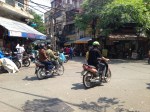
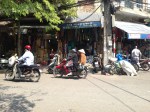



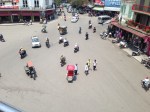


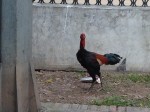
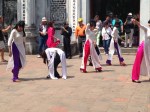
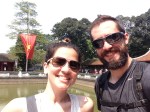

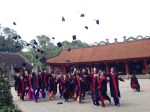
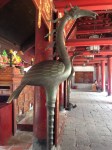


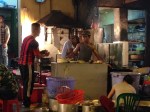



You seem to be following the same route that Gary Glitter took….
LikeLike